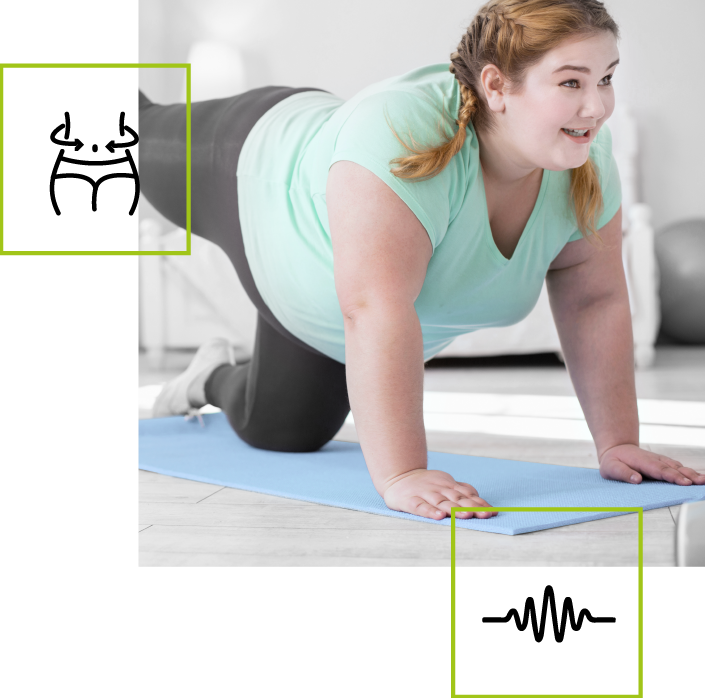Vibrotherapy – effective against obesity and overweight
Will vibrotherapy help you lose weight fast? Vibrotherapy treatments alone improve lipid profile and promote excessive weight loss, and when combined with a proper diet, one can expect sensational results.
How does it work?
Vibrotherapy, acting as a passive substitute for physical activity, raises metabolism and improves fat management.


When and for whom?
Overweight and obese people, especially those who have a hard time persevering with a proper diet and physical activity, including the elderly, should seriously consider vibrotherapy treatments to complement their weight loss program.
Effectiveness
In a scientific study using Vitberg vibrotherapy devices, improvements in lipid profile indices were observed after just three weeks of oscillatory-cycloidal vibration therapy for women over 65. In contrast, the application of 30 treatments on the same device to a group of 21 men of similar age (60-70) in another scientific study also had a positive effect on obesity.

Kabata-Piżuch A, Suder A, Jagielski P, Kubasiak K, Handzlik P, Teległów A, Marchewka A. Effect of Vibrotherapy on Body Fatness, Blood Parameters and Fibrinogen Concentration in Elderly Men. J Clin Med. 2021 Jul 23;10(15):3259
Benefits of vibrotherapy

No side effects

Action confirmed by scientists and practitioners

Perceptible effects from 1 treatment

Long-lasting effects through systematic use
Choose the right product
We will help you select a set of modules that suits your conditions.
What is overweight and obesity?
Overweight and obesity are two related health conditions characterised by excessive body fat accumulation.
Overweight is a condition in which a person has an excessive amount of body weight in relation to their height, but is not yet considered obese. Overweight is usually assessed using the body mass index (BMI), which is calculated based on a person's weight and height. A BMI between 25 and 29.9 is considered overweight. Being overweight can lead to a variety of health problems, such as an increased risk of heart disease, type 2 diabetes, high blood pressure and other conditions.
Obesity, on the other hand, is a condition in which fat tissue accumulates in the body in excessive amounts, which can lead to significant health problems. Obesity is usually defined as a BMI of 30 or more. Obesity is a complex health condition that can have serious effects on the body. High levels of body fat are associated with an increased risk of a number of diseases, including diabetes, heart disease, respiratory disease, joint disorders, and some types of cancer.
Both conditions, overweight and obesity, can affect quality of life, physical fitness and the body's overall ability to function. Maintaining a healthy weight and aiming to maintain a healthy body fat level is important to stay fit and avoid many of the diseases associated with obesity. In extreme cases - it is important to consult a doctor or nutritionist to determine appropriate weight management and healthy lifestyle strategies.
How do you fight excessive weight?
The fight against overweight and obesity is a multifaceted process that requires changes in eating habits, increased physical activity and a psychological approach.
Here are some steps that can be taken to effectively manage overweight and obesity:
Balanced diet: Focus on eating healthy, whole foods such as fruit, vegetables, whole grains, protein and low-fat dairy products. Limit your intake of saturated fats, trans fats and simple sugars. Monitor your calorie intake and avoid overeating.
Regular physical activity: Incorporate regular exercise into your daily schedule, such as walking, jogging, swimming, cycling or fitness. Aim to exercise for at least 150 minutes a week, as recommended by the World Health Organisation. Choose activities you enjoy to keep you motivated.
Monitor your progress: Regularly track your weight, progress in weight loss and overall health. Record your goals and review your progress to keep you motivated.
Change eating habits: Avoid eating in front of the TV or computer, which can encourage overeating. Eat slowly and chew each bite thoroughly, which helps you feel satiated.
Supportive environment: Seek support from family and friends. You may consider attending support groups or consulting a nutritionist or personal trainer.
Weight loss with vibration therapy
Vibrotherapy uses special devices that generate vibrations to stimulate muscles and fat tissue. It is used in conjunction with exercise and diet. There are scientifically validated reports of the positive effects of vibrotherapy in reducing body fat and improving muscle performance, confirming the effectiveness of this method in the fight against overweight and obesity. Physical activity reduces hyperglycaemia, insulin resistance, dyslipidaemia and hypertension and leads to improved vascular function in people with type 2 diabetes and is considered the cornerstone of its treatment. Unfortunately, not all patients can or want to participate in exercise classes. Vibrotherapy can be an alternative for such cases. Previous research confirms that vibration can be a way to improve body composition and muscle strength. In addition, just one vibration workout improves blood flow in the legs and reduces arterial stiffness, improves endothelial function and increases nitric oxide levels.
Physical activity without fatigue
Twelve weeks of vibration training results in significant weight loss, lower BMI, reduced waist circumference and a decrease in body fat percentage. Vibrotherapy has a positive effect on arterial blood flow. Changes in blood flow are significantly associated with changes in fat mass. Visceral (abdominal) fat is associated with arterial stiffness, so the results of the study were the first to present a significant relationship between improved blood flow and percentage fat mass after vibration training. The loss of fat from the abdominal region contributes to improved blood flow by increasing insulin-mediated vasodilation. Thus, reduction of abdominal fat may be a major factor in improving insulin sensitivity associated with training in people with type 2 diabetes.





